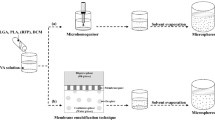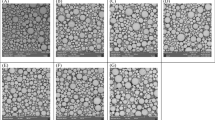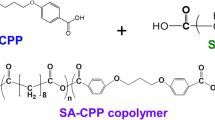Abstract
In this study, the use of biodegradable polymers for microencapsulation of naltrexone using solvent evaporation technique is investigated. The use of naltrexone microspheres for the preparation of matrix devices is also studied. For this purpose, poly(L-lactide) (PLA) microspheres containing naltrexone prepared by solvent evaporation technique were compressed at temperatures above the Tg of the polymer. The effect of different process parameters, such as drug/polymer ratio and stirring rate during preparation of microspheres, on the morphology, size distribution, and in vitro drug release of microspheres was studied. As expected, stirring rate influenced particle size distribution of microspheres and hence drug release profiles. By increasing the stirring speed from 400 to 1200 rpm, the mean diameter of microspheres decreased from 251 μm to 104 μm. The drug release rate from smaller microspheres was faster than from larger microspheres. However, drug release from microspheres with low drug content (20% wt/wt) was not affected by the particle size of microspheres. Increasing the drug content of microspheres from 20% to 50% wt/wt led to significantly faster drug release from microspheres. It was also shown that drug release from matrix devices prepared by compression of naltrexone microspheres is much slower than that of microspheres. No burst release was observed with matrix devices. Applying higher compression force, when compressing microspheres to produce tablets, resulted in lower drug release from matrix devices. The results suggest that by regulating different variables, desired release profiles of naltrexone can be achieved using a PLA microparticulate system or matrix devices.
Similar content being viewed by others

References
Bullingham RE, McQuay HJ, Moore RA. Clinical pharmacokinetics of narcotic agonist-antagonist drugs. Clin Pharmacokinet. 1983; 8:332–343.
Way WL, Fields HL, Way EL. Opioid analgesics and antagonists. In: Katzung BG, ed. Basic and Clinical Pharmacology. 7th ed. Norwalk, CN: Appleton and Lange; 1998:512–513.
Chiang CN, Holister LE, Kishimoto A, Barnett G. Kinetics of naltrexone, sustained release preparations. Int J Clin Pharmacol Ther. 1984; 36:704–708.
Wise DL. Controlled release for use in treatment of narcotic addiction. In: Langer, RS, Wise DL, eds. Medical Application of Controlled Release. Vol. 2. Boca Raton, FL: CRC Press; 1984:108–112.
Medical Economics staff. Production Information: Trexan. In: Physicians Desk Reference. 53rd ed. Montvale, NJ: Medical Economics Co Inc; 1999:936–938.
Oslen JL, Knel FA. A review of parenteral sustained release naltrexone systems. In: Willet RE, Barnett G, eds. NIDA Research Monograph No. 28. Washington DC: DHHS; 1981:187–193.
Sharon AC, Wise DL. Development of drug delivery systems for use in treatment of narcotic addiction. In: Willet RE, Barnett G, eds. NIDA Research Monograph No. 28. Washington DC: DHHS; 1981:194–213.
Roskos KV, Tefft JA, Fritzinger BK, Heller H. Development of a morphine-triggered naltrexone delivery system. J Control Release. 1992; 19:145–160.
Bodmier R, McGinity JW. The preparation and evaluation of drug-containing poly(dl-lactide) microspheres formed by the solvent evaporation method. Pharm Res. 1987; 4:465–471.
Maa YF, Heller J. Controlled release of naltrexone pamoate from linear poly(ortho esters). J Control Release. 1990; 14:21–28.
Misra AL, Pontani RB. An improved long-acting delivery system for narcotic antagonists. J Pharm Pharmacol. 1978; 30:325–326.
Nitsch MJ, Banakar UV. Implantable drug delivery. J Biomater Appl. 1994; 8:247–265.
Pechnick RN, Terman GW. The role of opiate receptors in the potentiation of pentobarbital sleeping time by the acute and chronic administration of opiates. Neuropharmacology. 1987; 26:1589–1593.
Bardo MT, Neisewander JL. Chronic naltrexone supersensitizes the reinforcing and locomotor-activating effects of morphine. Pharmacol Biochem Behav. 1987; 28:267–273.
Bardo MT, Neisewander JL, Ennis RB. Chronic treatment with naltrexone enhances morphine-stimulated dopamine neurotransmission: neurochemical and behavioural evidence. Neuropharmacology. 1988; 27:1103–1109.
Yamaguchi K, Anderson JM. Biocompatibility studies of naltrexone sustained release formulations. J Control Release. 1992; 19:299–314.
Martin WR, Harris LS, Dewey WL. Naltrexone zinc tannate: a prolonged-action narcotic antagonist complex. J Pharm Sci. 1974; 63:159–161.
Negishi N, Bennet DB, Cho C, Jeong SY, Van Heeswijk WAR, Feijen J, Kim SW. Coupling of naltrexone to biodegradable poly(α-amino acids). Pharm Res. 1987; 4:305–310.
Sidman KR, Schwope AD, Steber WD, Rudolph SE. Use of synthetic polypeptides in the preparation of biodegradable delivery systems for narcotic antagonists. In: Willet RE, Barnett G, eds. NIDA Research Monograph No. 28. Washington DC: DHHS; 1981:214–231.
Tefft JA, Roskos KV, Heller J. The effect of lipase on the release of naltrexone from triglyceride-coated cellulose acetate phthalate microspheres. J Biomed Mater Res. 1992; 26:713–724.
Nakayama GR, Roskos KV, Fritzinger BK, Heller J. A study of reversibly inactivated lipases for use in a morphine-triggered naltrexone delivery system. J Biomed Mater Res. 1995; 29:1389–1396.
Bhargava HN, Matwyshyn GA, Gerk PM, et al. Effects of naltrexone pellet implantation on morphine tolerance and physical dependence in the rat. Gen Pharmacol. 1994; 25:149–55.
Chiang CN, Hollister LE, Gillespie HK, Foltz RL. Clinical evaluation of a naltrexone sustained release preparation. Drug Alcohol Depend. 1985; 16:1–8.
Yang Q, Owusu-Ababio G. Biodegradable progesterone microsphere delivery system for osteoporosis therapy. Drug Dev Ind Pharm. 2000, 26:61–70.
Tamilvanan S, Sa B. Studies on the in vitro release characteristics of ibuprofen loaded microspheres. J Microencapsul. 2000; 17:57–67.
Capan Y, Woo BH, Gebrekidan S, Ahmed S, DeLuca PP. Influence of formulation parameters on the characteristics of poly(D,L-lactide-co-glycolide) microspheres containing poly(L-lysine) complexed plasmid DNA. J Control Release. 1999; 60:279–286.
Ravivarapu HB, Lee H, DeLuca PP. Enhancing initial release of peptide from poly(d,l-lactide-co-glycolide) (PLGA) microspheres by addition of a porosigen and increasing drug load. Pharm Dev Technol. 2000;5:287–296.
Cardinal JR. Matrix systems. In: Langer RS, Wise DL, eds. Medical Applications of Controlled Release Systems. Vol 1. Boca Raton, FL: CRC Press Inc; 1984:43–44.
Song SZ, Cardinal JR, Kim SH, Kim SW. Progestin permeation through polymer membranes, V: progesterone release from monolithic hydrogel devices. J Pharm Sci. 1981; 70:216–221.
Soppimath KS, Kulkarn AR, Aminabhavi TM. Encapsulation of antihypertensive drugs in cellulose-based matrix microsphere: characterization and release kinetics of microspheres and tableted microspheres. J Microencapsul. 2001;18:397–405.
Schmitt EA, Flanagan DR, Linhardt RJ. Degradation and release properties of pellets fabricated from three commercial poly(DL-lactide-co-glycolide) biodegradable polymers. J Pharm Sci. 1993;82:326–329.
Migliaresi C, Cohn D, De Lollis A. Dynamic mechanical and calorimetric analysis of compression molded PLLA of different molecular weights: effects of thermal treatments. J Appl Polymer Sci. 1991;43:83–95.
Dinarvand R, Imani M, Ryahipoor F, Atyabi F. Preparation of a biodegradable matrix system for contraceptive drug delivery. Drug Delivery Sys Sci. 2001; 1:73–76.
Cohn D, Younes H, Marom G. Amorphous and crystalline morphologies in glycolic acid and lactic acid polymers. Polymer. 1987; 28:2018–2022.
Gilding DK, Reed AM. Biodegradable polymers for use in surgery: polyglycolic acid/poly(lactic acid) homo- and copolymers. Polymer. 1979; 20:1459–1464.
Omelczuk MO, McGinity JW. The influence of polymer glass transition temperature and molecular weight on drug release from tablets containing Poly(DL-lactic acid). Pharm Res. 1992;9:26–32.
Author information
Authors and Affiliations
Corresponding author
Rights and permissions
About this article
Cite this article
Dinarvand, R., Moghadam, S.H., Mohammadyari-Fard, L. et al. Preparation of biodegradable microspheres and matrix devices containing naltrexone. AAPS PharmSciTech 4, 34 (2003). https://doi.org/10.1208/pt040334
Received:
Accepted:
DOI: https://doi.org/10.1208/pt040334



